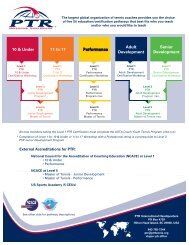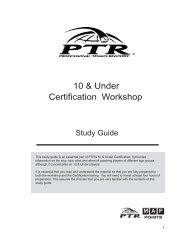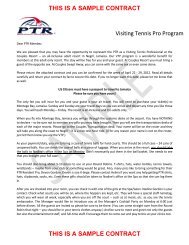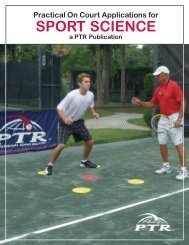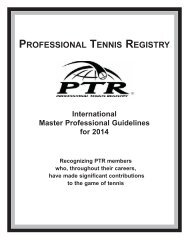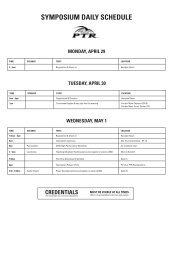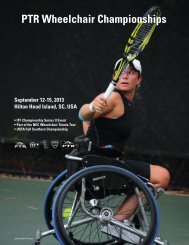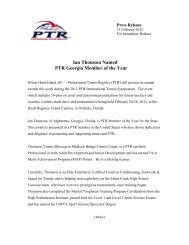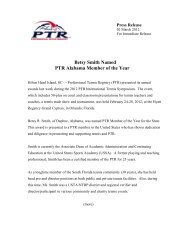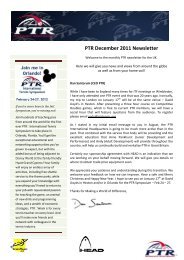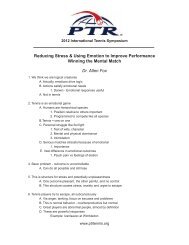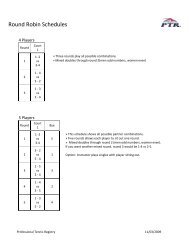Certification Workshop - Professional Tennis Registry
Certification Workshop - Professional Tennis Registry
Certification Workshop - Professional Tennis Registry
You also want an ePaper? Increase the reach of your titles
YUMPU automatically turns print PDFs into web optimized ePapers that Google loves.
GENERAL TEACHING CONSIDERATIONS<br />
Here are a few general comments from PTR Founder Dennis Van der Meer that will help you<br />
become a great instructor. You should review these suggestions in preparation for the<br />
certification test.<br />
• Keep group lessons moving. Don’t spend extra time with a slower learner in the beginning<br />
of the lesson. Wait for the opportunity to work with them in the Individual Help portion. It’s<br />
important to keep everyone in lockstep so the lesson doesn’t lose momentum, and worse<br />
yet, lose some of your students’ attention.<br />
• Make frequent comments to everyone in the lesson. Use the students’ names to<br />
personalize your comments and bring attention to their individual needs.<br />
• Vary the tone and volume of your voice. It’s important to interject excitement and energy<br />
into the learning of the game. Your voice and attitude will relay your enjoyment of the game<br />
and keep your student returning.<br />
• Corrective techniques are easier to administer in the Individual Help portion of the lesson.<br />
But remember to keep your eyes moving as the instructor. You have to see and attend to<br />
everyone!<br />
• There is nothing more important than the safety of your students. Be sure to position the<br />
ball hopper correctly and be aware of the spacing between your students at all times.<br />
• As an instructor, your stroke demonstrations need to be controlled and absent of any<br />
idiosyncratic movements. You do not need to demonstrate any stroke at a fast playing<br />
speed for a beginning student. Be aware of your own playing limitations.<br />
• Stay away from detailed descriptions of a stroke’s movement. Most will learn much faster<br />
from a more “show and tell” method. Too much information may paralyze your students,<br />
and you will lose their attention.<br />
• Sometimes students who have played for many years have developed inefficient<br />
mechanics, yet they still maintain a good deal of success and are comfortable with their<br />
play. It is most important to get their cooperation before making any substantial change to<br />
their game. And it is always easier for students to accept an addition to their game rather<br />
than a change.<br />
• Give frequent feedback to your students, always finding the opportunity to be positive and<br />
motivating. For slower learners, look for small improvements to praise. Too much criticism<br />
can defeat a student’s desire to continue playing.<br />
22 PTR ADULT DEVELOPMENT CERTIFICATION WORKSHOP TEST PREPARATION GUIDE



